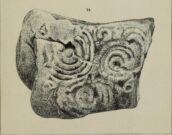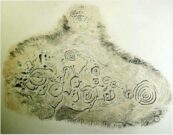Cup-and-Ring Stone (lost): OS Grid Reference – NY 909 702
Archaeology & History

The whereabouts of this carving is somewhat of a mystery. Originally found three or four hundred yards away to the northeast of Chesters mansion, it was moved from there into the porch entranceway of the place—and here it lived for, hmmmm….well, we’re not quite sure how long it was here. The only description of the carving seems to have been made by the Rev. G.R. Hall in 1887, and between then and sometime in the 20th century, it’s disappeared to god-knows-where. The only known photo of the carving (right) suggests that the original design was somewhat bigger as the stone looks to have been broken off from a larger piece. Mr Hall told us:
“this stone is 3 feet in length by 2 feet 6 inches in breadth, of irregular form. It has five incised cups on each side of a wide, slightly curved channel, which crosses the stone at nearly its widest part. Two other grooves intersect this longest channel, one forming a segment of a circle. At the opposite end of the slab are two nearly parallel grooves passing towards the largest hollow. The ten cups vary from 1½ inches to 3 inches in diameter, and are from half an inch to an inch in depth.”
All being well, the carving is hiding in a wall somewhere, or maybe beneath His Lordship’s bed. Hopefully it’ll re-appear sometime soon…
References:
- Beckensall, Stan, Northumberland’s Prehistoric Rock Carvings – A Mystery Explained, Pendulum: Rothbury 1983.
- Hall, G.R., “On Some Cup-incised Stones, found in an Ancient British Burial-mound at Pitlands Hills, near Birtley, North Tynedale,” in Archaeologia Aeliana (2nd Series) volume 12, 1887.
© Paul Bennett, The Northern Antiquarian




